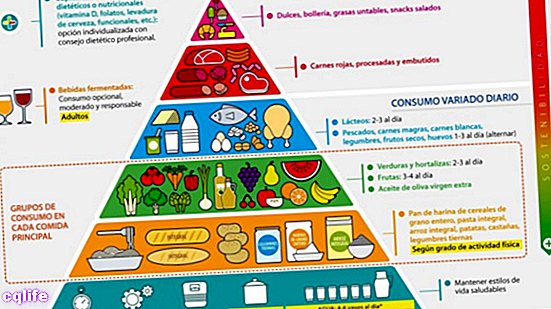We explain what the food pyramid is, its function, how it was created, and what food group each step represents.

What is the food pyramid?
It is known as the food pyramid, nutritional pyramid, food pyramid or other similar names, a graphic model of what are the food that we should consume daily and in what proportions to stay healthy.
As its name implies, it is a pyramid or triangle segmented into five or six hierarchical links, ordered from the base to the top, in each of which a certain type of food substance is represented. Each step has a different size, to indicate the proportions in which the food should be consumed, to maintain a diet that equally satisfies all the needs of the body.
Food pyramids can vary depending on the model accepted in each country, especially when they are adapted to the foods present in their diet and their culture gastronomic; but in general they obey the same nutritional principle that establishes a daily intake of 55% carbohydrates, 30% fats and 15% of protein, fibers, vitamins and minerals, such as the ideal proportion recommended for human being.
Each of these food groups is usually represented with a specific color, a specific drawing, or simply noted on its corresponding rung of the pyramid, and often accompanied by the portions that its size represents.
The first nutritional pyramids were created at the end of the 19th century, but perhaps the best known of all was the one created in the United States by the Department of Agriculture in 1992, and which was later revised and reformulated in 2005 (under the name “My Pyramid: steps to a healthier you", That is," My pyramid: steps to make you healthier "), in order to incorporate the need for physical exercise as part of the daily routine.
There are, of course, alternative versions of this pyramid, adapted to the Mediterranean diet, to the Arab and Jewish ways of eating, and even a nutritional pyramid vegan. There are also other graphic formats to display the same information, such as the food wheel.
According to the food pyramid, of the Spanish Foundation of Nutrition Community, the suggested proportion of food would be the following:

- Top of the pyramid. Foods that should be eaten sporadically, that is, not daily, as they are tasty but do not provide any important nutritional content, such as sweets, salty snacks, spreadable fats and sugary drinks.
- Second step. Foods that should be eaten occasionally and moderately, although in greater quantity, since they have essential nutrients and proteins, but also high fat content. Among them are sausages, red meats, cold cuts and processed meats.
- Third rung. Foods that should be consumed daily in a variety of ways, since they are the body's main source of energy and protein, but whose abuse brings problems metabolic and nutritional. We refer to dairy (2-3 servings daily) and lean meats, fish, white meat, legumes, nuts and eggs (1-3 servings daily, alternating between them).
- Fourth step. Recommended foods for daily consumption, which should abound in our diet. These are vegetables (2-3 servings daily), fruits (3-4 servings daily) and virgin olive oils.
- Base of the pyramid. Food that can be consumed on a daily basis, but always depending on the degree of physical exercise and daily activity. The more intense our days are, the more portions we can eat of them, and the less physically intense they are, the fewer portions we should eat. In this step are the bread made of whole grain cereal flour, whole wheat pasta, brown rice, potatoes, tender legumes and chestnuts.
In addition, the daily intake of between 4-6 glasses of water is recommended, as well as supplements and / or vitamin or nutritional supplements according to the specialized guide of a nutritionist, if applicable.
